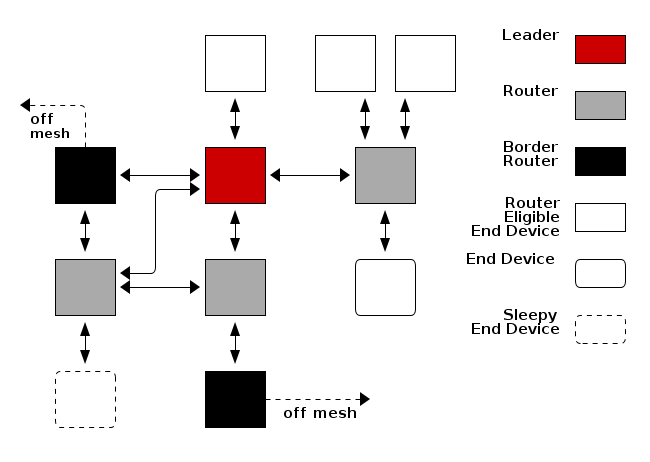SWRA654A December 2019 – April 2020 CC2652R , CC2652R7 , CC2652RSIP
3.2 Thread
Thread is a wireless protocol that operates at 2.4 GHz. There are four different devices in a Thread network: Leader, Router, Border Router, and End Device. All devices start as End Devices but are promoted as the network requires. There is only one Leader in the network that handles the decisions in the network, for example, Router upgrading. The Leader is elected by being the first Router in the network. The Routers handle the communication between devices in the network by transmitting, receiving, and forwarding data around the network. Routers can also act as parents for End Devices. When the Router is doing network activities, such as responding to network queries, they act as proxies for their children. Border Routers are Routers that act as a bridge between the Thread Network an adjacent network, like Wi-Fi or Ethernet. The End Device only connects to one Router, which handles all communication. If the connection between the End Device and its parent Router is lost, the End Device will search for a new Router.
For another device to join the network, they have to know the channel and master-key. This information is shared when the attaching device is authenticated before securely brought onto the network, also known as the commissioning process. There are two different categories when it comes to commissioning: external and native commissioning. For off-mesh nodes, such as Border Routers, external commissioning is required. Native commissioning is used for the on-mesh nodes.
 Figure 4. A Typical Thread Network
Figure 4. A Typical Thread Network Thread devices can be either a Full Thread Device (FTD) or a Minimal Thread Device (MTD). An FTD can be any of the above-mentioned roles, while an MTD can only be an End Device. An FTD can be configured at runtime to be an MTD, but the reversed is not permitted since the MTD does not contain all necessary sections to act as an FTD.
Thread networks use a mesh structure to transmit data over long distances. The data passes through multiple intermediary devices to reach the final destination in the remote device. The remote devices can be different kinds of sensors, for example, temperature, smoke detector, classification of sound, and so forth. The data can also be transferred off mesh by using the Border Routers to interface other networks. This way, the data from the sensors within the Thread Network will be available to send to the cloud, for example.
The TI-OpenThread stack is an open-source implementation of the Thread specification, designed and developed for single-threaded environments. The TI-OpenThread stack handles a queue of pending tasks to run. For more information, see TI-OpenThread User's Guide.